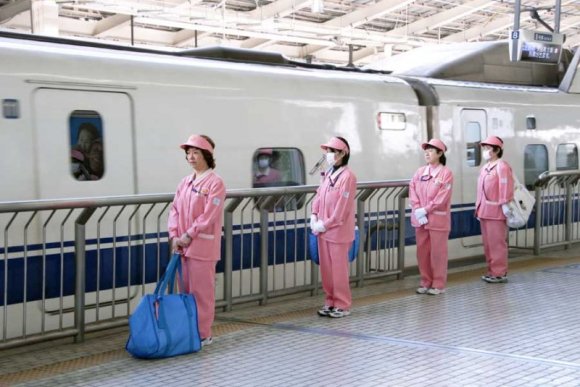
Japan’s shinkansen, or bullet train in the West, was the world’s first high-speed train running at 200km per hour, and today the Tōkaidō Shinkansen is the world’s most used high-speed rail line. Impressively, even with over 120,000 trains running on the line each year, the average delay time is a mere 36 seconds!
Part of the reason the bullet train system can run as smoothly as it does is thanks to the ‘hospitality group’ working behind the scenes of the sleek, futuristic facades of these famous trains. These cleaning crews are charged with covering every inch of a train’s interior when it arrives at its final stop and preparing it for the next wave of customers–and they have just seven minutes to do it.
What is TESSEI?
JR East’s rail service company is known as TESSEI, and it is responsible for the cleaning of the bullet trains when they have come to a stop at Tokyo Station. There are around 820 staff members including full-time staff and part-timers known as ‘partners’. The average employee age is 52, and around 50 percent of them are women, so people often talk affectionately of the TESSEI ‘obaa-sans’ or ‘grannies’.
Bullet trains shuttle in and out of the platforms at Tokyo station 210 times each day. TESSEI staff are divided into teams composed of 22 people, and with 11 teams of cleaners taking turns on the platform, which translates into each TESSEI employee cleaning around 20 trains per day.
Despite not being particularly glamorous work, the group has received a lot of media attention over the years, and have been called Japan’s ‘strongest team’ by the Nikkei Business magazine.
So what exactly does the job entail?
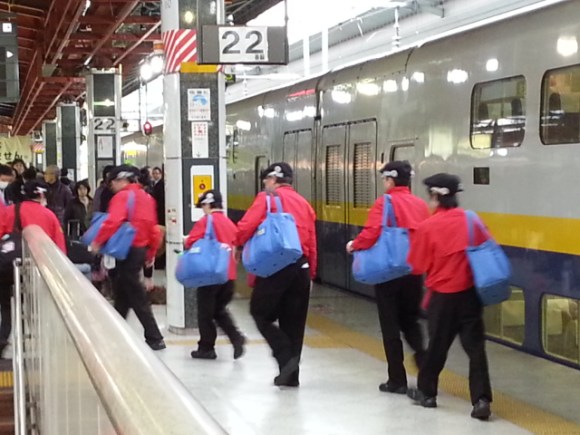
Speed cleaning
Trains spend only 12 minutes at the station in Tokyo. That includes two minutes for passengers to disembark and two more for the next to get on, leaving only seven minutes for cleaning.
One person is in charge of one car with around 100 seats, and the whole car must be made spotlessly clean during those crucial seven minutes. It’s the same for the toilet cleaning staff – no matter how dirty it is, they have to have it sparkling again within the time limit. And lest we forget, the shinkansen aren’t like inner-city trains — passengers often travel for hours at a time, getting settled for the long ride, eating meals, snacking, reading newspapers, and generally making a bit of a mess.
The strict seven-minute deadline means that the work is broken down into smaller blocks that have to be completed in record time: 1.5 minutes spent picking up trash, 30 seconds rotating the seats (some can be swivelled around so that larger groups can face one another), four minutes sweeping and cleaning, and a one-minute check.
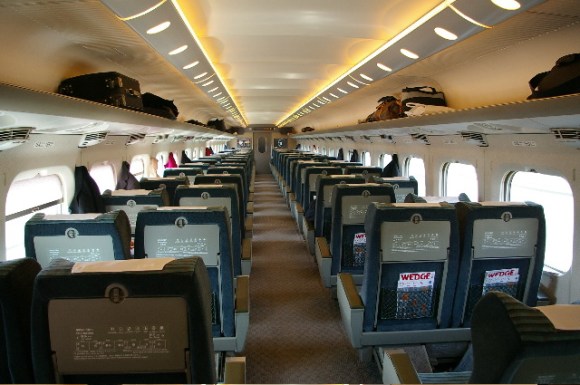
Those crucial seven minutes
0:00~1:30 First check the luggage racks on both sides, then look down the gaps between the seats for any forgotten items. As the seats are being turned to face the direction of travel, run down to the door at the other end sweeping out dropped trash into the aisle along the way.
1:30~4:30 On the way back up the aisle, pull down and check the blinds, and at the same time pull out the seat-back trays and wipe everything down, and change the seat covers if they’re dirty.
4:30~6:30 There’s now only two minutes left. Take a broom and sweep up all the trash brought out into the aisle in one go.
Everything above is expected to be completed in about six minutes. The official time limit is seven minutes, but it’s often crowded and takes longer for passengers to disembark, so they rarely have the luxury of using the full seven. This almost superhuman feat is known in Japanese as the ‘7-minute shinkansen theatre’
Why does it work?
TESSEI was reformed into the company it is today nine years ago. At the time the workers were treated as mere dispatch cleaners, and had low morale and dedication to their job. This led to the cleanliness of the shinkansen suffering and not living up to the expectations held by its millions of passengers.
One of the main changes involved in the overhaul was redefining the work as ‘service’ rather than ‘cleaning’, and endeavoring to create a sense of pride in the job. Another major factor is the importance of teamwork, with input coming not just from the supervisors but from everyone in the team. Every day they will hold a team meeting to thoroughly discuss any issues no matter how trivial, and every member gets a say. Furthermore, the teams are not fixed, and will be shuffled around so that everyone gets a chance to work with and learn from lots of different people.
From 2007 the Angel Report has been the most effective method of raising morale amongst the team members. This is a public report that’s sent out internally and pasted to the office walls where staff who have worked exceptionally hard are given a public shout-out and thanks.
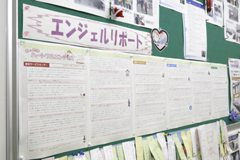
Omotenashi: Japanese hospitality
You might have heard the Japanese word ‘omotenashi’ in conjunction with the 2020 Olympic bid. It basically represents the concept of Japanese hospitality, and the country is very keen to continue to promote the image of politeness that many foreigners have of it.
TESSEI has its own brand of omotenashi that you can witness whenever you’re waiting to board the train, as the TESSEI staff line up to start their speed clean. One of the fascinating things for passengers, particularly foreigners, to observe is the way all the staff will bow to the train on its arrival and departure from the station, and to the passengers before they board.
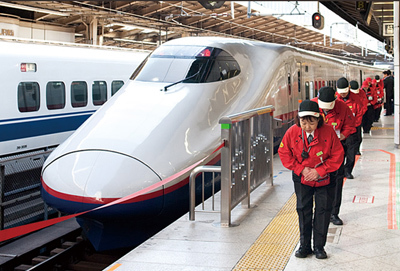
Other unique ideas to jazz up their job and put smiles on people’s faces have come from the staff themselves, such as having seasonal flowers on their hats, or wearing bright Hawaiian shirts in summer.
Celebrity endorsement (sort of)
TESSEI’s incredible service has garnered admiration and praise around the world. Upon visiting TESSEI, the French national rail president commented that he wanted to import the idea to France. And last month a group of professors from Harvard University visited TESSEI and discussed including the company in teaching materials at the graduate school of business.
But probably the best endorsement the group received was from former Governor of California and all-round badass Arnold Schwarzenegger, who expressly went to observe the group when he visited Japan with the American transport chief. If it’s good enough for the Terminator, then it’s probably good enough for the rest of us!
Source: Naver Matome
Header Image: Richard Young @ PBase.com

 Shinkansen: “Seats can be quickly used as shields in the event of an attack”
Shinkansen: “Seats can be quickly used as shields in the event of an attack” The ultimate Shinkansen trip: Riding Japan’s bullet train network from one end to the other
The ultimate Shinkansen trip: Riding Japan’s bullet train network from one end to the other Faster than a speeding bullet! Ride the Tokyo to Kyoto “Nozomi” Shinkansen with us! 【Video】
Faster than a speeding bullet! Ride the Tokyo to Kyoto “Nozomi” Shinkansen with us! 【Video】 This is how Japan’s train-cleaning crews clean the Shinkansen in only seven minutes
This is how Japan’s train-cleaning crews clean the Shinkansen in only seven minutes Is the Shinkansen bullet train Green Car upgrade worth it when traveling in Japan?【Photos】
Is the Shinkansen bullet train Green Car upgrade worth it when traveling in Japan?【Photos】 Top Japanese cosplayer Enako returns to Comiket after 6 years, creates mayhem with admirers
Top Japanese cosplayer Enako returns to Comiket after 6 years, creates mayhem with admirers Private booths are coming to Japan’s Shinkansen bullet trains even sooner than we’d thought【Video】
Private booths are coming to Japan’s Shinkansen bullet trains even sooner than we’d thought【Video】 Japanese beef bowl chain Sukiya’s 2026 Smile Box lucky bag basically pays for itself
Japanese beef bowl chain Sukiya’s 2026 Smile Box lucky bag basically pays for itself What makes a good boss in Japan? Workers sound off in survey
What makes a good boss in Japan? Workers sound off in survey Dragon Quest Burgers and Slime drinks are coming to McDonald’s Japan【Video】
Dragon Quest Burgers and Slime drinks are coming to McDonald’s Japan【Video】 Bear attack shelters going on sale in Japan as country experiences record-high number of incidents
Bear attack shelters going on sale in Japan as country experiences record-high number of incidents The meaning of the mandarin and 6 other Japanese New Year traditions explained
The meaning of the mandarin and 6 other Japanese New Year traditions explained The fantastic feast of festival food in Japan
The fantastic feast of festival food in Japan Cosplay costume room tour by Japan’s number-one cosplayer Enako is an eye-opener【Video】
Cosplay costume room tour by Japan’s number-one cosplayer Enako is an eye-opener【Video】 Japanese convenience store Christmas cakes are cuter than ever!
Japanese convenience store Christmas cakes are cuter than ever! Starbucks Japan ready to get Year of the Horse started with adorable drinkware and plushies【Pics】
Starbucks Japan ready to get Year of the Horse started with adorable drinkware and plushies【Pics】 Hayao Miyazaki says Happy New Year to Studio Ghibli fans with new art for Year of the Horse
Hayao Miyazaki says Happy New Year to Studio Ghibli fans with new art for Year of the Horse Cup Noodle tries an authentic Jiro-style ramen, but something’s not quite right
Cup Noodle tries an authentic Jiro-style ramen, but something’s not quite right The best Starbucks Japan Frappuccinos we want to drink again in 2026
The best Starbucks Japan Frappuccinos we want to drink again in 2026 We revisited Sweets Paradise after a decade to see if Japan’s dessert buffet still delivers
We revisited Sweets Paradise after a decade to see if Japan’s dessert buffet still delivers That time Seiji called JASRAC to ask why he didn’t get paid royalties for his song being on TV
That time Seiji called JASRAC to ask why he didn’t get paid royalties for his song being on TV We found possibly the quietest Japanese-style hotel in Tokyo’s bustling Shinjuku district
We found possibly the quietest Japanese-style hotel in Tokyo’s bustling Shinjuku district Pizza Hut Japan’s hot lucky bags are perfect for a New Year’s pizza party
Pizza Hut Japan’s hot lucky bags are perfect for a New Year’s pizza party Japan’s oldest largetooth sawfish in captivity back on display in Mie Prefecture
Japan’s oldest largetooth sawfish in captivity back on display in Mie Prefecture 7-Eleven Japan starts new temporary luggage storage service in over 300 branches
7-Eleven Japan starts new temporary luggage storage service in over 300 branches Disillusionment at Tsukiji’s tourist-target prices led us to a great ramen restaurant in Tokyo
Disillusionment at Tsukiji’s tourist-target prices led us to a great ramen restaurant in Tokyo Starbucks teams up with 166-year-old Kyoto doll maker for Year of the Horse decorations【Photos】
Starbucks teams up with 166-year-old Kyoto doll maker for Year of the Horse decorations【Photos】 Tokyo considering law requiring more trash cans following litter increase in heavily touristed area
Tokyo considering law requiring more trash cans following litter increase in heavily touristed area Tokyo’s Tsukiji sushi neighborhood asks tour groups to stay away for the rest of the month
Tokyo’s Tsukiji sushi neighborhood asks tour groups to stay away for the rest of the month Tokyo event lets you travel back in time, for free, to celebrate 100 years since Showa era start
Tokyo event lets you travel back in time, for free, to celebrate 100 years since Showa era start Japan may add Japanese language proficiency, lifestyle classes to permanent foreign resident requirements
Japan may add Japanese language proficiency, lifestyle classes to permanent foreign resident requirements Sanrio theme park in Japan announces plans to expand into a Sanrio resort
Sanrio theme park in Japan announces plans to expand into a Sanrio resort Stamina-destroying “Paralysis Noodles” are Tokyo’s newest over-the-top ramen innovation
Stamina-destroying “Paralysis Noodles” are Tokyo’s newest over-the-top ramen innovation Survey asks foreign tourists what bothered them in Japan, more than half gave same answer
Survey asks foreign tourists what bothered them in Japan, more than half gave same answer Japan’s human washing machines will go on sale to general public, demos to be held in Tokyo
Japan’s human washing machines will go on sale to general public, demos to be held in Tokyo Japan’s deadliest food claims more victims, but why do people keep eating it for New Year’s?
Japan’s deadliest food claims more victims, but why do people keep eating it for New Year’s? We deeply regret going into this tunnel on our walk in the mountains of Japan
We deeply regret going into this tunnel on our walk in the mountains of Japan Studio Ghibli releases Kodama forest spirits from Princess Mononoke to light up your home
Studio Ghibli releases Kodama forest spirits from Princess Mononoke to light up your home Major Japanese hotel chain says reservations via overseas booking sites may not be valid
Major Japanese hotel chain says reservations via overseas booking sites may not be valid Put sesame oil in your coffee? Japanese maker says it’s the best way to start your day【Taste test】
Put sesame oil in your coffee? Japanese maker says it’s the best way to start your day【Taste test】 No more using real katana for tourism activities, Japan’s National Police Agency says
No more using real katana for tourism activities, Japan’s National Police Agency says Starbucks Japan reveals new sakura drinkware collection, inspired by evening cherry blossoms
Starbucks Japan reveals new sakura drinkware collection, inspired by evening cherry blossoms Updated cherry blossom forecast shows extra-long sakura season for Japan this year
Updated cherry blossom forecast shows extra-long sakura season for Japan this year Bullets on the bullet train as three men found carrying guns on Japan’s Shinkansen
Bullets on the bullet train as three men found carrying guns on Japan’s Shinkansen A guide to riding the Shinkansen bullet train with a terrible-twos kid
A guide to riding the Shinkansen bullet train with a terrible-twos kid $2.34!? Cheapest bullet-train ride in Japan lasts 3 minutes, but memories are forever【Photos】
$2.34!? Cheapest bullet-train ride in Japan lasts 3 minutes, but memories are forever【Photos】 Evangelion Shinkansen service takes off on November 7 with life-sized Eva cockpit on board
Evangelion Shinkansen service takes off on November 7 with life-sized Eva cockpit on board How to order snacks on a Shinkansen bullet train in Japan
How to order snacks on a Shinkansen bullet train in Japan New Shinkansen bullet train design revealed for Nagasaki extension
New Shinkansen bullet train design revealed for Nagasaki extension Evangelion Shinkansen gets range of souvenirs, including its very own bullet train ekiben obento
Evangelion Shinkansen gets range of souvenirs, including its very own bullet train ekiben obento Shinkansen ice cream sales suspended on board bullet train, sell out online
Shinkansen ice cream sales suspended on board bullet train, sell out online Japan’s West Kyushu Shinkansen bullet train service to Nagasaki is set to open this fall
Japan’s West Kyushu Shinkansen bullet train service to Nagasaki is set to open this fall Nozomi Shinkansen bullet train abolishes low-priced unreserved tickets during peak travel seasons
Nozomi Shinkansen bullet train abolishes low-priced unreserved tickets during peak travel seasons Traveler in Japan filled with gratitude as bullet train conductor shares Shinkansen lifehack
Traveler in Japan filled with gratitude as bullet train conductor shares Shinkansen lifehack New Shinkansen design unveiled, bullet train exterior includes cherry blossom Easter egg
New Shinkansen design unveiled, bullet train exterior includes cherry blossom Easter egg Stranded passengers on Shinkansen bullet train served out-of-date bread during typhoon
Stranded passengers on Shinkansen bullet train served out-of-date bread during typhoon Japan’s Shinkansen bullet train will start offering wider seats, but will charge more for them too
Japan’s Shinkansen bullet train will start offering wider seats, but will charge more for them too Shinkansen driver disciplined for taking poop break while train was going 150 kilometers an hour
Shinkansen driver disciplined for taking poop break while train was going 150 kilometers an hour Hello Kitty Shinkansen Cafe: A delicious stop on the most kawaii bullet train in Japan
Hello Kitty Shinkansen Cafe: A delicious stop on the most kawaii bullet train in Japan
Leave a Reply